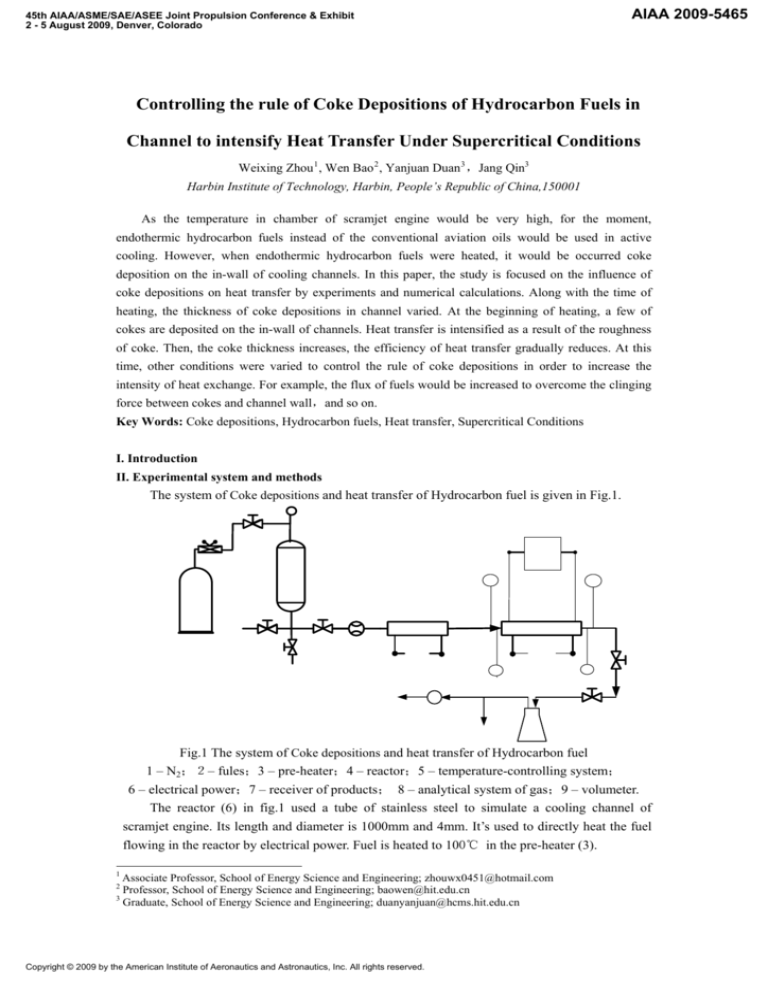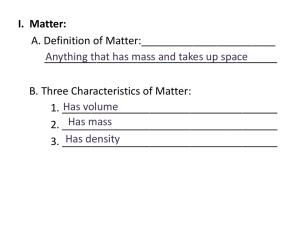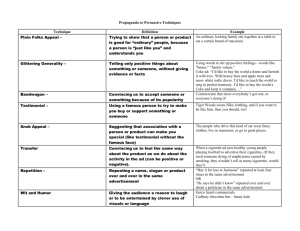
45th AIAA/ASME/SAE/ASEE Joint Propulsion Conference & Exhibit
2 - 5 August 2009, Denver, Colorado
AIAA 2009-5465
Controlling the rule of Coke Depositions of Hydrocarbon Fuels in
Channel to intensify Heat Transfer Under Supercritical Conditions
Weixing Zhou 1 , Wen Bao 2 , Yanjuan Duan 3 ,Jang Qin3
Harbin Institute of Technology, Harbin, People’s Republic of China,150001
As the temperature in chamber of scramjet engine would be very high, for the moment,
endothermic hydrocarbon fuels instead of the conventional aviation oils would be used in active
cooling. However, when endothermic hydrocarbon fuels were heated, it would be occurred coke
deposition on the in-wall of cooling channels. In this paper, the study is focused on the influence of
coke depositions on heat transfer by experiments and numerical calculations. Along with the time of
heating, the thickness of coke depositions in channel varied. At the beginning of heating, a few of
cokes are deposited on the in-wall of channels. Heat transfer is intensified as a result of the roughness
of coke. Then, the coke thickness increases, the efficiency of heat transfer gradually reduces. At this
time, other conditions were varied to control the rule of coke depositions in order to increase the
intensity of heat exchange. For example, the flux of fuels would be increased to overcome the clinging
force between cokes and channel wall,and so on.
Key Words: Coke depositions, Hydrocarbon fuels, Heat transfer, Supercritical Conditions
I. Introduction
II. Experimental system and methods
The system of Coke depositions and heat transfer of Hydrocarbon fuel is given in Fig.1.
Fig.1 The system of Coke depositions and heat transfer of Hydrocarbon fuel
1 – N2;2– fules;3 – pre-heater;4 – reactor;5 – temperature-controlling system;
6 – electrical power;7 – receiver of products; 8 – analytical system of gas;9 – volumeter.
The reactor (6) in fig.1 used a tube of stainless steel to simulate a cooling channel of
scramjet engine. Its length and diameter is 1000mm and 4mm. It’s used to directly heat the fuel
flowing in the reactor by electrical power. Fuel is heated to 100℃ in the pre-heater (3).
1
Associate Professor, School of Energy Science and Engineering; zhouwx0451@hotmail.com
Professor, School of Energy Science and Engineering; baowen@hit.edu.cn
3
Graduate, School of Energy Science and Engineering; duanyanjuan@hcms.hit.edu.cn
2
Copyright © 2009 by the American Institute of Aeronautics and Astronautics, Inc. All rights reserved.
III. Numerical model of the wall temperature
One dimension equation of tube reactor is following:
2
T λ ∂T
= qV
λ∂ 2 + ⋅
r ∂ r
∂r
(1)
then,heat source qv –heat density caused by electrical current, which heated the
3
tube wall, is named volume heat load (W/m ).
Fig.2 The partial sect of reactor
Thermal equilibrium on the outer-wall and the inner-wall of reactor:
qV ⋅ V = qS1 ⋅ S1 + q S 2 ⋅ S 2
(2)
Thermal density is given by equation (1) and (2):
q S 1 = qV ⋅
(R
− R12 ) R2
−
⋅ qS 2
R1
2 ⋅ R1
2
2
(3)
Thermal conductivity:
q S 1 = −λ ⋅
∂T
∂r
(4)
Then,
⎛R ⎞
⎛
⎞ 1
(R 2 − R12 )
R2
T1 = T2 − ⎜⎜ qV ⋅ 2 − R2 ⋅ q S 2 ⎟⎟ ⋅ ⋅ ln⎜⎜ 2 ⎟⎟ − qV ⋅ 2
2
4⋅λ
⎝
⎠ λ
⎝ R1 ⎠
(5)
Thermal equilibrium:
q s1 ⋅ 2πR1dx = m& ⋅ C p ⋅ dT f
(6)
Newton equation:
qs1 = α ⋅ (T1 − T f )
(7)
Then,
Nu = α ⋅ 2 R1 / λ
(8)
IV. Experimental result
Fig.3 is given the quantities of coke deposition on the in-wall of each segment of reactor.
Reactor is divided into 20 segments after 30min heating. The quantities of coke depositions is the
least in the middle of tube.
Fig.3 The quantities of coke deposition on the in-wall of each segment of reactor
It is illuminated the distribution of heat transfer coefficient on the in-wall of reactor in fig.4.
The intensity of heat transfer in the front of 200mm tube and in the back of reactor decreased along
with heating time. However, the heat transfer from 200mm to 900mm of the reactor increased. This
phenomena is illuminated that heat transfer is intensified as a result of the roughness of coke. Then, the
coke thickness increases, the efficiency of heat transfer gradually reduces.
Fig.4 The distribution of heat transfer coefficient on the in-wall of reactor
References
[1] Fu Quanjun, Yan Ke, Du Zonggang, Li Ning. Research progress of endothermic
hydrocarbon fuels. Journal of Rocket Propulsion2005.Vol.31.№5.
[2] Long Term Deposit Formation in Aviation Turbine Fuel at Elevated Temperature / Giovanetti
A.J., Szetela E.J. // AIAA – Paper , 1986, N0 – 526, 11p.
[3] Yanovskiy L.C.,Ivanov V.F., Galimov F.M., Sapgir G.B.: Coke Depositions in Aviation and Rocket
Engines. Kazan, 1999.Abak.
[4] Yanovskiy L.S., Martynenko S.I., Baykov A.V. Heat and Mass Transfer at Turbulent Flow of
Endothermic Hydrocarbon Fuels in Channels under Supercritical Pressure.ISABE-2005-1075.
[5] Wickhan D. T., Engel J.R., Karpuk M.E. Additives to Prevent Filamentous Coke Formation in
Endothermic Heat Exchangers Prepr Paf-Am Chen Soc, Div Pet Chem,2000,45(3).459-464.
[6] Gao Han, Li Zuguang, Li Gang, Zhu Wanliang, Lin Ruisen. BUILDING OF ENDOTHERMIC
FUEL COOLING SIMULATION SYSTEM. Journal of Propulsion Technology. 1999.
Vol.20.№5.
[7] Guo Yongsheng, He Long, Fang Wenjun, Lin Ruiseng. STUDY ON PYROLYSIS-CRACKING COKE OF
ENDOTHERMIC HYDROCARBON FUELS Journal of Fuel Chemistry and Technology. 2003.Vol.31.
№4.300-304.
[8] Zhu Yuhong, Yu Caixiang, Li Zimu. Formation of Coke in Thermal Cracking of Jet Fuel Under
Supercritical Conditions 2006,35(12):1151-1155.








